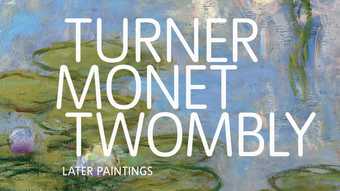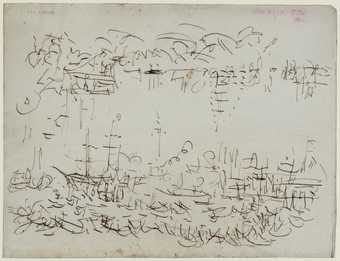I came to J.M.W. Turner’s Light and Colour (Goethe’s Theory) – the Morning after the Deluge – Moses Writing the Book of Genesis 1843 after reading Jonathan Crary’s book Techniques of the Observer: On Vision and Modernity in the Nineteenth Century. Crary writes about the visual culture of the Victorian era and the industrial revolution, showing how innovations in different fields gave rise to new insights about the nature of vision. Nowhere is this clearer than in the evolution of Turner’s painting practice. Not only did he master the techniques of his genre, he went on to challenge and reformulate some of its most basic principles. In his late works, in particular, the familiar features of traditional landscape painting – horizon line, single-point perspective, the illusion of depth, the scenery itself – dissolve into a painterly mist, while the perceptual effects of light and colour emerge as objects of contemplation in their own right.
In the title of this painting, Turner references the optical experiments of Johann Wolfgang von Goethe, whose writings include a study of after-images, the coloured spots produced in the eye by staring directly at the sun. For Goethe, after-images were proof that the eye was not simply a passive receiver of light rays, as common logic of the time had it. There were subtle eccentricities to the sense of sight; the eye was even capable of generating its own internal lighting and colour effects.
Light and Colour (Goethe’s Theory), painted at the end of the artist’s career, is a startling visual counterpart to Goethe’s theories. As Crary describes it, the ‘view of the sun that had dominated so many of Turner’s previous images now becomes a fusion of eye and sun. Through the after-image the sun is made to belong to the body, and the body in fact takes over as the source of its effects.’ The painting represents a significant shift from an understanding of reality as being ‘out there’ to something formed by the viewer.

Paul Pfeiffer
Goethe’s Message to the New Negroes #1, #2 and #3 2002
Digital video loop, cast LCD monitor, DVD player and metal armature
14 x 16.5 x 91.4 cm
Courtesy Thomas Dane © Paul Pfeiffer
You assume that in a sunset picture what you have is the sun moving towards a stable horizon. In the same way that the focus of the gaze in Turner’s painting is no longer a single-point perspective, I wanted to invert that idea in my Morning After The Deluge 2003, making the sun the stable element and the horizon the unstable one. In fact, Turner actually takes the horizon out of the picture, dispensing with the usual reference point thought to be fundamental in structuring a landscape painting.
I’m attracted to source material that is already quite loaded, although I’m not referring to religious painting per se, but more to the perception of religious history and art history as some kind of evolving perceptual consciousness. In religious paintings the centre of the image is often the most important part. Crary talks about Turner’s sun pictures as self-portraits, and my video Vitruvian Figure – After Pavia Cathedral 1998 is, in a way, a kind of figure study. At the same time I always have this strange feeling that I’m not actually taking up the centre of the picture, or that something else is there as well.
Turner’s painting is a significant art historical marker. He has taken a simple subject – the sun – and given it a sense of timelessness and universality. I shot Morning After The Deluge in real time. I was interested in the idea that the video loop represents a disturbing notion of time being something that you can actually freeze. When you look at the image you don’t see anything happening. The sun and the horizon don’t seem to move. You might think it’s a still unless you happen to look at it at a moment when a bird is flying by. You could call this piece romantic. It’s really quite saturated. It has a very dramatic composition, but it pulls the ground out from under the viewer, creating an optical space for him or her to stand in.

Paul Pfeiffer
John 3:16 (2000) 2000
Digital video loop, cast LCD monitor, DVD
14 x 16.5 x 91.4 cm
Courtesy Thomas Dane © Paul Pfeiffer
My starting point for this piece is very personal and reflects my interest in identity in relation to picture making. It has much to do with very early experiences of dislocation and a feeling that, visually, things often don’t make sense. For example, during an early period of my life I was living in the Philippines where my parents were teachers. It was a real pocket of American culture in a very small, rural, tropical environment. We got more than our fair share of American pop culture coming through the television and movies. It felt like a kind of displacement, growing up imbibing American images at one remove. With digital media there is a return to this type of disembodied relation, in terms of a classical understanding of the body – to the kind of vision which is so physically mediated that, for me, it becomes unclear where the boundary between the human body and the machine begins.




